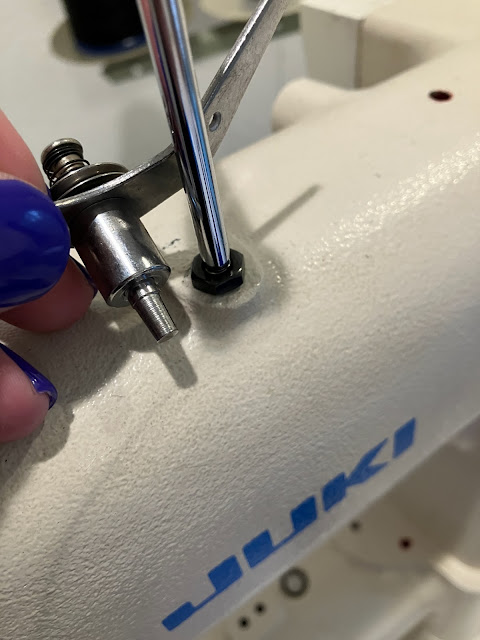So my Juki LS-321 has this upper thread guide.
The thread comes off the thread tree, through the long arm of the guide, between the tension disks, then through the short arm of the guide and down into the main tension mechanism on the front of the machine. This essentially accomplishes two things at once: it gets the thread across from the back of the machine to the front, while applying a small amount of tension to keep the thread under control.
The problem is that, being mounted so high up on the machine, and being relatively spindly and exposed, it is rather prone to getting damaged.
Somehow someone who owned this machine before me had managed to chip one of the tension disks, which is honestly kind of impressive and I'm not even sure how they did it, and also cracked the arm itself which is somewhat less unexpected all things considered.
Now these weren't fatal failures; the arm was still basically holding together and the chipped tension disc wasn't causing too many issues, but it was only a matter of time before things would get worse, so a replacement was in order.
Unfortunately for us, this particular mechanism is no longer manufactured, and, given how prone it is to being damaged, it is not readily available as NOS or as a used part salvaged off of other machines.
So where, you might ask, did I find this?
Well, the sewing machine industry is never one to let a good part go to waste. If they've set up a manufacturing line to build a part, they're going to run that line into the ground. And, given they'll have an ample supply of that part, they'll use it across a variety of different machines. Then those machines will get cloned by their competitors who will set up their own manufacturing lines, then those competitors will use those parts across their own variety of different machines, and perhaps you can figure out where we're going from here.
It took a while, but as I was idly surfing through craigslist one day I came across a Brother DB2-B755-3 flatbed sewing machine, much like this one.
And wouldn't you know it, right there on top there's a familiar looking part, and looking it up in the parts manual lists it as Brother part number 144502-0-01.
But there is one tiny difference.
The Brother thread guide uses a tapered pin to fit into the top of the machine, whereas the Juki uses a screw thread with a jam nut. However, while a number of things are broken on the existing thread guide, the post was not one of them. (Well, sort of. The post is bent slightly and shows signs of having been snapped off at one point, but there's enough thread left for it to be mounted securely and the bend isn't really noticeable in practice so we'll just pretend it's perfect)
So, the simple solution is to just reuse it.
They both use a 5mm shaft, and so the parts from one can just be slid onto the other, and vice versa.
Now there are some subtle differences with the new guide.
For one, the long and short arms are at a different angle, essentially a mirror image of each other. You might think this would cause an issue, but actually it works out slightly better: with the long arm still pointed towards the thread tree, the short arm has a better reach out over the front of the machine.
The other minor difference is that the end of the long arm is not bent down to allow the thread from the thread tree to feed in from the top. I double-checked the manual for the Brother machine, and the way they have it illustrated is for the thread to come up from the bottom, wrap around the side, and then up from the bottom again before going between the tension discs counter-clockwise and down through the hole in the short arm.
Neither of these differences are very critical, as we can see in the sample sewing here.
The two lines of heavy black stitches were done on my Juki after replacing the thread guide, and they look pretty much perfect to me.
If you're curious, the three lines of stitching next to them were done on my Singer 251, and the neon green at the top left was me playing around with the stretch stitches on m Brother domestic machine.







No comments:
Post a Comment